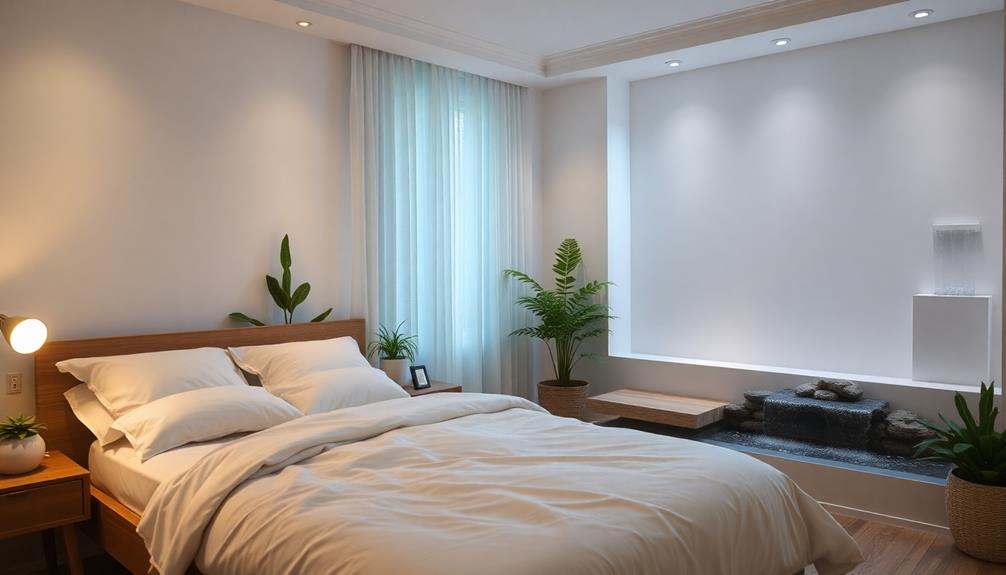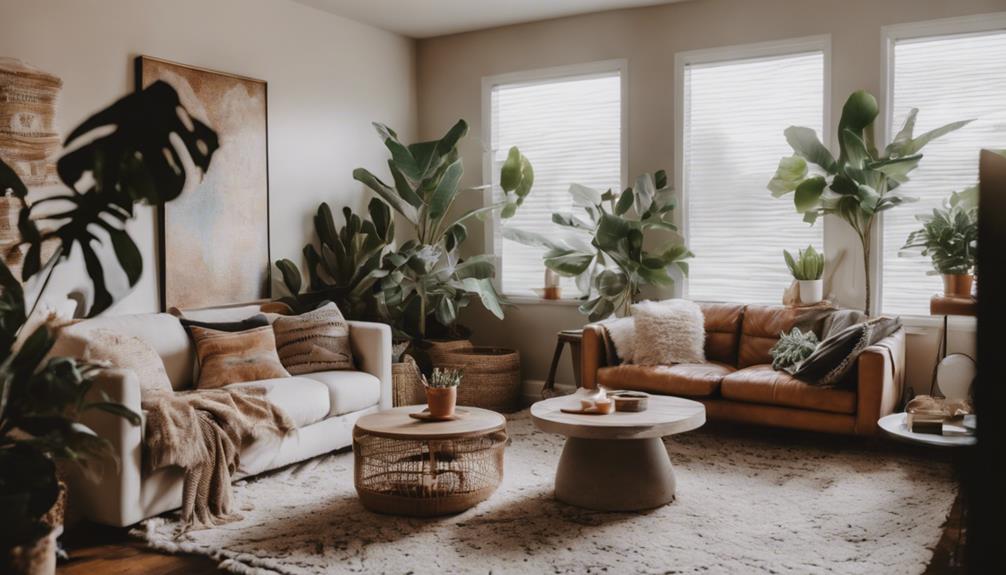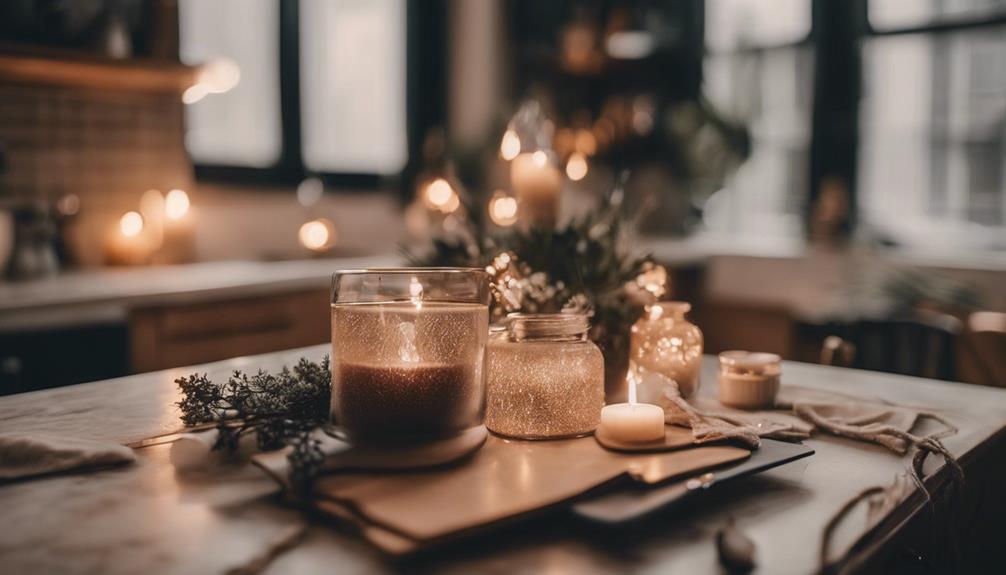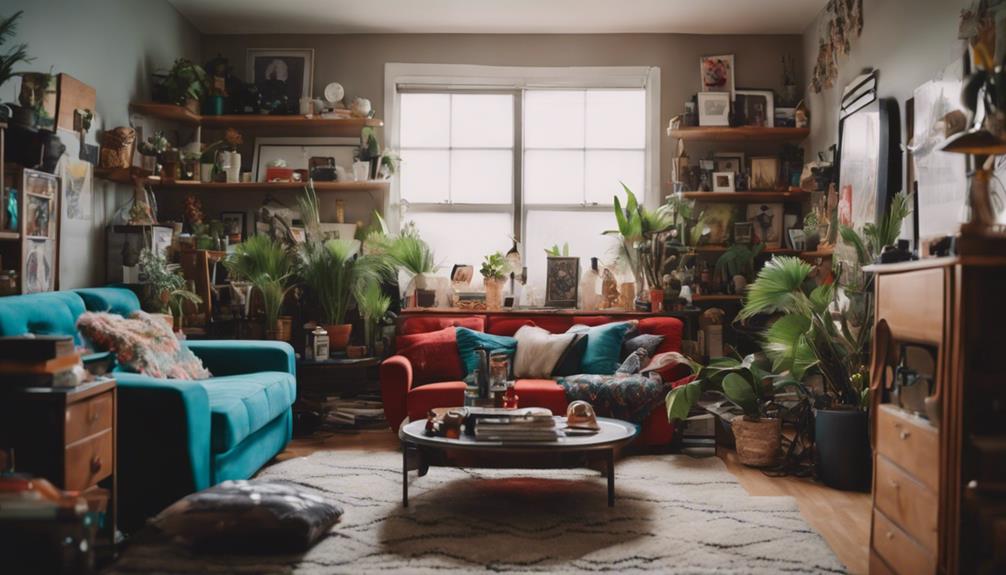To enhance your sleep tonight, consider rearranging the positioning of your bed to improve Feng Shui. Place it in the command position, where you can have a view of the door but are not directly in line with it. This helps create a feeling of security. Additionally, declutter your space, particularly under the bed, to avoid stagnant energy that may disrupt your sleep. Using soft earth tones in your decor can help promote relaxation. Lastly, minimize electronics around your sleeping area to create a peaceful environment. By incorporating Feng Shui principles, you can find more simple tips to improve your sleep.
Key Takeaways
- Position your bed in the command position for a sense of security and improved energy flow while sleeping.
- Declutter your bedroom to eliminate stagnant energy and create a peaceful sleeping environment.
- Use calming colors like soft earth tones to promote relaxation and a tranquil atmosphere.
- Minimize electronics in the bedroom to reduce EMF exposure and enhance sleep quality.
- Incorporate calming elements like plush pillows and crystals, such as amethyst, to foster a restful environment.
Understanding Feng Shui Basics
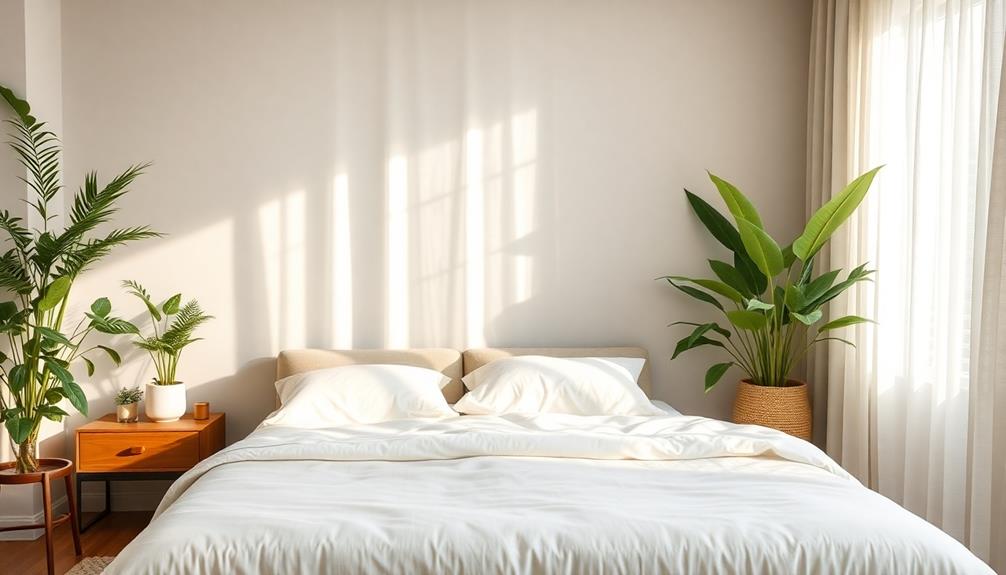
Feng Shui is all about creating harmony in your environment, which can greatly enhance your well-being. With roots over 3,000 years old in ancient China, Feng Shui translates to "wind" and "water," symbolizing the connection between nature and human life.
Understanding the basics of Feng Shui means recognizing how your surroundings impact various aspects of life, like health and relationships. Incorporating elements of design, such as those found in Balinese interior design, can enhance the natural flow of energy in your space.
At the core of good Feng Shui is the concept of energy, or Chi, and the balance and harmony between this energy and your living space. You mightn't realize it, but the way you arrange your furniture and decor can greatly affect your energy flow.
For instance, an ideal layout promotes tranquility and stability, making it easier for you to relax and recharge.
Feng Shui integrates elements from physics, philosophy, and astrology, ensuring your space feels inviting and peaceful. By focusing on these principles, you can create a restful environment that supports restorative sleep, allowing you to wake up refreshed and ready to take on the day.
Embrace these Feng Shui basics, and you'll start experiencing the benefits in no time.
Importance of Bed Placement
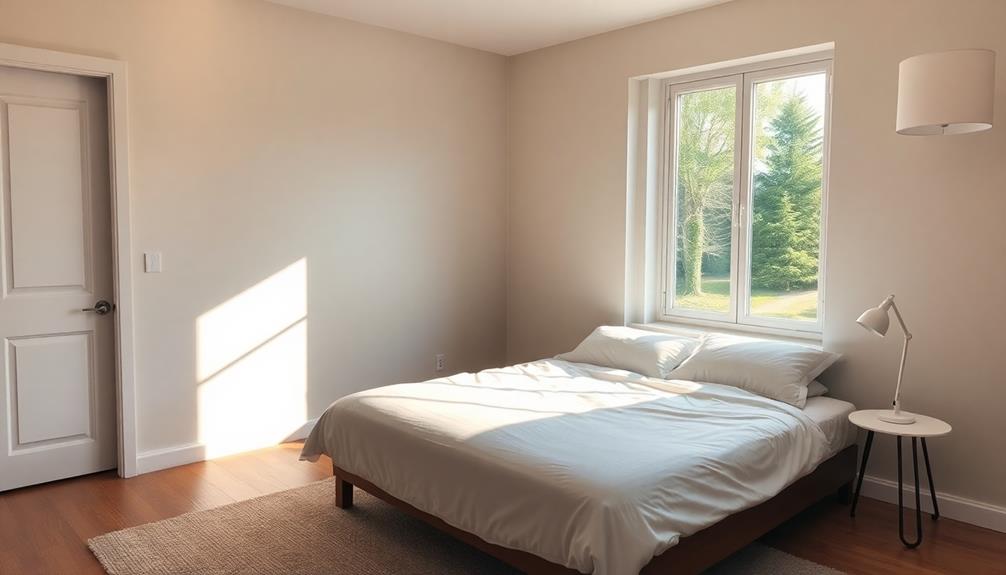
The way you position your bed plays an important role in creating a harmonious sleeping environment. Proper bed placement according to Feng Shui principles can greatly influence your money, relationships, health, and overall stability. To enhance your sense of security and promote restful sleep, position your bed in the command position. This means you should have a clear view of the door without being directly in line with it.
Additionally, aligning your headboard with the direction that activates desired life areas based on your Gua number can optimize your energy flow in the bedroom. Avoid placing your bed in corners, as this promotes feelings of entrapment and limits openness, which are crucial for a relaxing sleep environment.
Here's a quick reference table to help you understand the importance of bed placement:
| Bed Placement Tips | Benefits |
|---|---|
| Command Position | Enhances security |
| Clear View of the Door | Promotes restful sleep |
| Align Headboard with Gua | Optimizes energy flow |
| Avoid Corners | Prevents feelings of entrapment |
| Enhances Overall Energy Flow | Improves sleep quality |
Decluttering for Better Sleep

To sleep better, start by removing unwanted items from your bedroom that create chaos and negative energy.
Incorporating elements of traditional artistry, such as Indonesian decor masks, can enhance the aesthetic appeal of your space while promoting a calming atmosphere.
Make sure the space under your bed is clear to prevent stagnant energy from affecting your rest.
Establishing a regular tidying routine will help maintain a serene environment that supports deeper sleep.
Remove Unwanted Items
Every evening, the state of your bedroom can greatly impact your ability to unwind and fall asleep. Decluttering the bedroom is essential for creating a peaceful environment that promotes restorative sleep. Incorporating elements like Indonesian decorative pillows can add comfort and cultural charm while removing unwanted items that carry negative memories or evoke stress.
Each object holds its energy, and clutter can symbolize negative thoughts, making it vital to maintain an organized space. When you eliminate these distractions, you allow positive energy to flow freely, reducing stagnant energy that can disrupt sleep quality.
Focus on surfaces and corners, and don't forget to check under the bed, where hidden clutter often lurks. This area can harbor stagnant energy, further interfering with your ability to relax.
Regularly tidying up and letting go of items that no longer serve you will create a sense of calm, making it easier to drift off at night. Additionally, consider incorporating eco-friendly products and linens to detoxify your bedroom environment, ensuring you reduce exposure to harmful toxins.
Organize Under-Bed Space
Creating a serene sleeping environment means paying attention to the often-overlooked space under your bed. This area can greatly impact your sleep quality. When you clutter this space with unused items, you risk accumulating stagnant energy, which may lead to disturbed sleep patterns and negative thoughts.
Traditional housing designs, like those found in Rumah Adat, often emphasize the importance of open, uncluttered spaces to promote positive energy flow. By focusing on decluttering, you can promote positive energy flow, enhancing the overall atmosphere of your bedroom.
Consider using neutral under-bed storage solutions to keep this area organized. This approach not only prevents emotional clutter but also allows for unobstructed energy flow, contributing to a more tranquil and restful sleeping environment.
Regularly check what's beneath your bed and remove unnecessary items, ensuring that only essentials remain. A clean under-bed area can transform your bedroom into a peaceful sanctuary, supporting relaxation and restorative sleep.
With less clutter, you'll likely feel less stressed and more at ease as you wind down for the night. Investing time in organizing this space is a simple yet effective Feng Shui trick that can help you enjoy better sleep tonight and beyond.
Regular Tidying Routine
Your bedroom's tidiness plays an important role in your sleep quality. Implementing a regular tidying routine can notably reduce stress and create a calming atmosphere, which is vital for restful sleep. Clutter represents negative thoughts and energy, so by decluttering your space, you can foster a more peaceful environment. Incorporating elements like Indonesian decor masks can enhance your space's aesthetic appeal while also promoting cultural appreciation.
Every object in your bedroom carries its own energy. Regularly evaluating and removing items that evoke negative memories or feelings can enhance your emotional well-being.
You'll notice that as you clear out unwanted items, you create space for positive energy to flow, helping you feel more relaxed and prepared for sleep.
An organized bedroom aligns with Feng Shui principles, promoting tranquility and improving your overall sleep patterns. When you maintain a tidy space, you not only encourage better sleep but also contribute to a sense of harmony in your life.
Set aside a few minutes each day to tidy up and prioritize your sleep sanctuary. You'll find that a clutter-free environment enhances your ability to unwind and recharge, leading to a more restorative night's sleep.
Embrace the transformative power of decluttering, and watch your sleep quality improve.
Choosing the Right Headboard
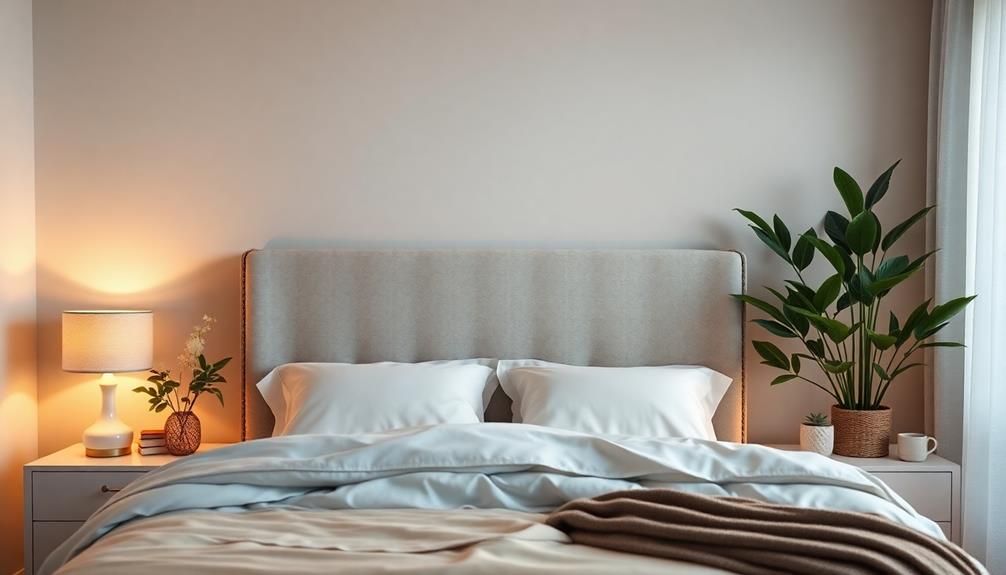
When it comes to choosing the right headboard, it's essential to focus on both aesthetics and energy flow. A solid headboard, particularly one made from wood, offers vital support and grounding energy that promotes restful sleep. This aligns with principles from bedroom feng shui, enhancing the overall stability of your sleep environment.
Additionally, consider incorporating natural materials that reflect the calming ambiance of traditional Indonesian style home decor, as these can further enhance the soothing atmosphere of your bedroom.
Consider these three key factors when selecting your headboard:
- Material: Avoid metal and glass headboards, as they can disrupt restful sleep. Opt for solid wood to attract good energy and provide a comforting presence.
- Design: Choose headboards with smooth edges. Sharp edges can direct negative Chi, which isn't conducive to a calming atmosphere.
- Height: Confirm your headboard complements the height of your mattress. This allows energy to flow beneath, enhancing the room's feng shui.
Creating a Calming Color Palette
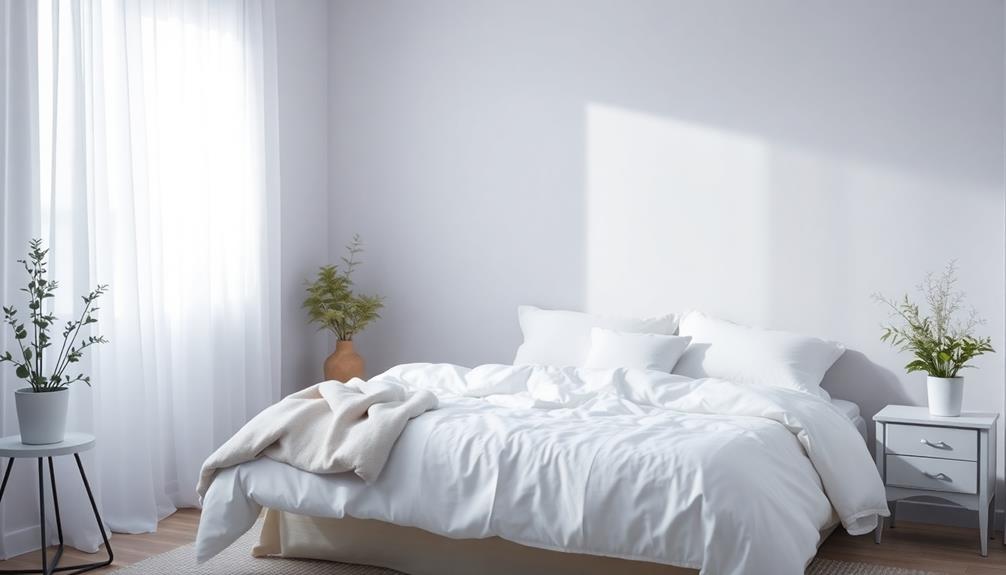
To foster a tranquil sleeping environment, selecting a calming color palette is essential. Start by incorporating soft earth tones, creams, and light browns into your bedroom decor. These calming colors enhance relaxation and promote restful sleep, creating a serene atmosphere that supports your body's natural rhythms.
Consider utilizing high-quality materials sourced locally, similar to the offerings from Mahallati Interiors, which focus on creating serene and inviting spaces.
Avoid bright colors that can be overly stimulating and disrupt your ability to unwind. Intense shades, like fiery reds or emotional blues, may evoke heightened feelings, which isn't conducive to quality sleep. Instead, focus on neutral colors that invite tranquility and help to settle your mind after a long day.
A well-thought-out color palette plays a significant role in the overall energy of your space. By choosing hues that reflect calmness, you're setting the stage for relaxation.
This thoughtful approach not only influences your mood but also has a direct impact on the quality of your sleep. Remember, your bedroom should be a sanctuary, so opt for colors that wrap you in comfort and serenity.
With the right palette, you'll find it easier to drift off into a peaceful slumber.
Balancing Yin and Yang Elements
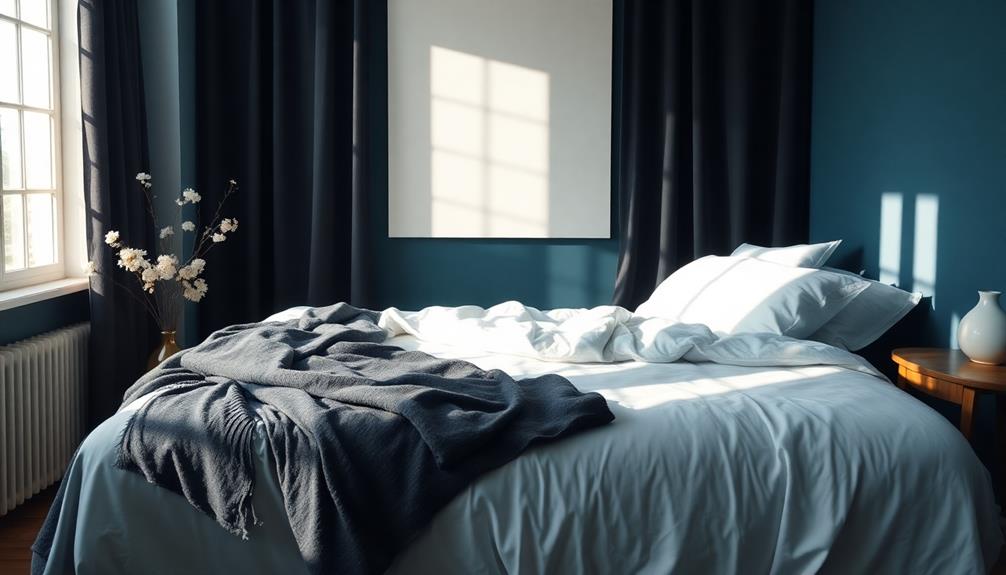
To create a restful sleep environment, you need to balance the yin and yang elements in your bedroom.
Focus on harmonizing textures, colors, and furnishings to adjust the energy flow and promote tranquility.
Incorporating natural materials and tropical villa plans can enhance the calming atmosphere.
Understanding Yin and Yang
Balancing Yin and Yang elements in your bedroom is essential for creating a restful sleep environment. Yin represents calmness and softness, while Yang embodies brightness and stimulation. Achieving a harmonious balance between these energies can profoundly impact your sleep quality, much like the way modern tropical aesthetics in Bali seamlessly blend indoor and outdoor environments to foster tranquility.
To effectively balance Yin and Yang in your bedroom, consider these three key elements:
- Textiles: Incorporate soft pillows, cozy blankets, and plush rugs to enhance the Yin aspect. They promote relaxation and create a nurturing atmosphere.
- Color Palette: Use muted colors for your walls and decor to foster tranquility. Avoid overwhelming Yang colors like bright reds or yellows that can stimulate energy and disrupt your peace.
- Lighting: Opt for functional lighting that's adjustable. Soft, warm lights can enhance Yin while still allowing for Yang elements when needed.
Regularly evaluating and adjusting the balance of Yin and Yang in your bedroom is crucial. By maintaining this equilibrium, you'll create a tranquil haven that not only supports restful sleep but also rejuvenates your spirit.
Embrace this balance to transform your bedroom into a serene retreat.
Harmonizing Bedroom Elements
Creating a harmonious bedroom involves thoughtfully blending elements that embody both Yin and Yang energies. Balancing these energies is essential for restful sleep and relaxation. To energize your home and create a feng shui haven, consider incorporating soft furnishings alongside structured elements. Soft textures like plush cushions and flowing curtains introduce Yin energies, promoting calmness and serenity, while sturdy furniture and clean lines provide the stabilizing Yang element. A simple feng shui color trick is to incorporate soothing, muted tones such as soft blues or earthy neutrals to enhance relaxation, while brighter accents like red or gold can energize and uplift the space. Ensuring this balance of material and color will ultimately create a bedroom that fosters both peace and rejuvenation.
Here's a simple guide to harmonizing your bedroom:
| Yin Elements | Yang Elements |
|---|---|
| Plush pillows and blankets | Solid wood bed frame |
| Soft pastels and earth tones | Structured furniture |
| Gentle plants | Crystals |
| Clutter-free space | Defined areas for activity |
Using neutral colors promotes calmness, while solid wood provides stability. Position your furniture to allow for easy movement and a natural flow, steering clear of clutter or sharp edges that disrupt harmony. Integrating natural elements like crystals or plants not only invites healing energy but also balances the overall ambiance.
Adjusting Energy Flow
Achieving a balanced energy flow in your bedroom is key to enhancing your sleep quality. To create this harmonious environment, you need to balance both yin and yang energies. Here are three effective tips for adjusting energy flow: First, arrange your bed so it is positioned away from the door but with a clear view of it, promoting a sense of security and balance. Additionally, consider incorporating natural elements like plants or wooden furniture to harmonize with the yin energy, creating a serene and calming atmosphere. Lastly, the combination of optimizing your space’s altitude and coffee brewing setup in the morning can positively influence the energy in your bedroom by promoting a smooth transition from rest to wakefulness.
- Incorporate Soft Textures: Use plush bedding and cushions to boost yin energy, promoting relaxation and comfort. Consider integrating tropical-themed luxury designs to enhance the serene atmosphere in your bedroom.
- Maintain Solid Elements: Include firm items like wooden furniture to support yang energy, providing strength and stability in your space.
- Choose Calming Colors: Opt for earth tones and neutrals to foster a serene atmosphere, balancing the energetic dynamics in your home.
Additionally, arrange your furniture to allow ample open space, preventing feelings of clutter or entrapment. This promotes a smooth flow of positive energy.
A solid wall behind your bed can also enhance your sense of security, supporting restorative sleep. Regularly revitalizing your bedroom through cleaning or reorganizing helps prevent stagnation, ensuring the energy in your home remains vibrant and conducive to a restful night.
Reducing Electronics in the Bedroom
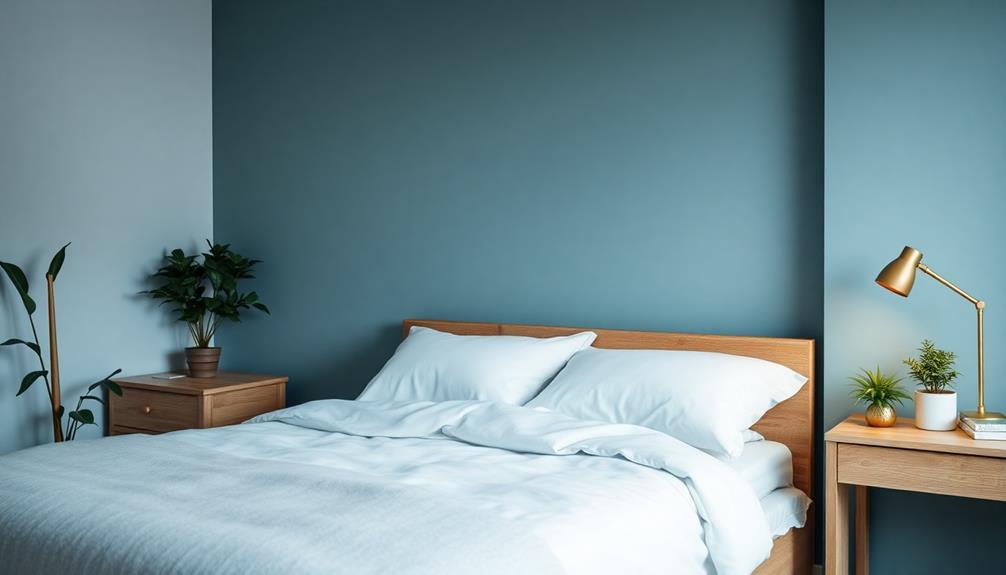
Reducing electronics in the bedroom can transform your sleep environment and greatly enhance your rest. By minimizing electronic devices, you lower your exposure to electromagnetic fields (EMFs), which can disrupt your sleep quality. Screens, particularly those on phones and tablets, emit blue light that hinders melatonin production, making it harder to drift off. Limiting screen time before bed is essential for achieving restful sleep.
To further improve your sleep environment, position TVs and other electronics at least 4 to 5 feet away from your bed. This simple adjustment helps reduce the impact of EMFs on your body. Additionally, consider turning off your WiFi at night; this small step can create a more peaceful atmosphere, conducive to relaxation.
Creating a tech-free zone in your bedroom encourages a calming atmosphere that promotes better sleep hygiene. Without the distractions of devices, you'll find it easier to unwind and prepare for a good night's sleep.
Establishing a Restful Evening Routine

A peaceful bedroom sets the stage for a restful evening routine that can considerably improve your sleep quality.
Establishing a calming pre-sleep ritual is essential for signaling to your body that it's time to wind down. By incorporating Feng Shui principles, you can create a serene environment that promotes good nights.
Here are three key practices to enhance your evening routine:
- Limit Screen Time: Avoid emails and social media at least 60 minutes before bedtime. This helps reduce mental stimulation and stress, allowing your mind to relax.
- Create a Consistent Bedtime Schedule: Going to bed and waking up at the same time each day regulates your sleep patterns, leading to improved sleep quality and duration.
- Engage in Relaxing Activities: Consider listening to calming instrumental music or practicing gentle stretches. These activities can further enhance your pre-sleep ritual, making it easier for you to shift into sleep.
Enhancing Sleep With Feng Shui Crystals
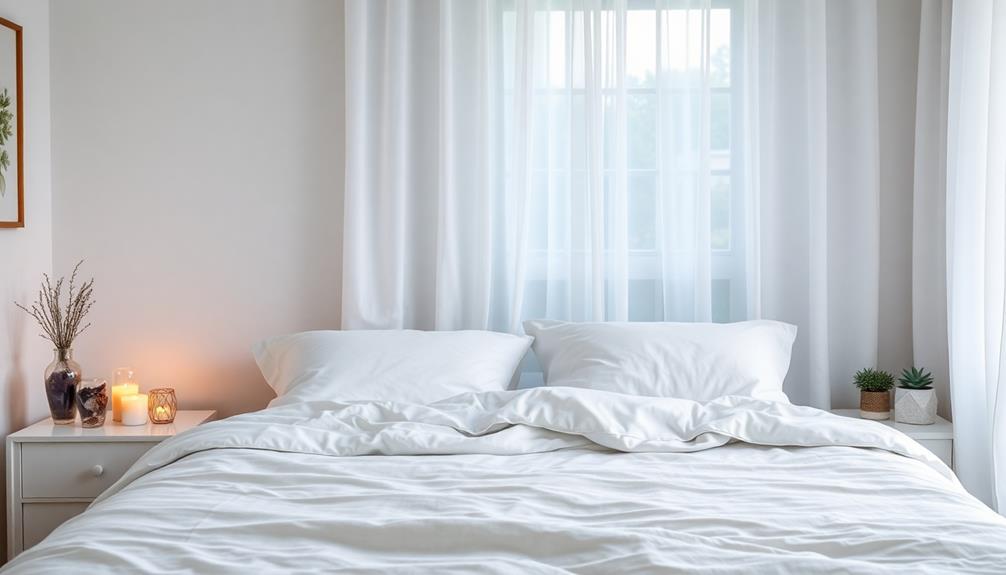
Transform your sleep environment by incorporating Feng Shui crystals, which can greatly enhance your restfulness. Amethyst is a fantastic choice for your bedroom; its soothing energy promotes peace of mind and restful sleep when placed on your nightstand or under your pillow.
By introducing these crystals into your space, you create a harmonious atmosphere that eases restlessness during the night, allowing for deeper, more restorative sleep.
To maximize the benefits of Feng Shui crystals, remember to cleanse and recharge them regularly. This practice guarantees they maintain their positive energy, enhancing their effectiveness in your bedroom.
Additionally, consider adding rose quartz, which fosters love and emotional healing, contributing to a tranquil sleeping environment.
For an extra touch of balance and harmony, incorporate one or three stalks of bamboo in your bedroom. Bamboo symbolizes strength and resilience, creating an even more supportive atmosphere for sleep.
Frequently Asked Questions
What Is the Best Feng Shui for Sleeping?
To achieve the best feng shui for sleeping, position your bed in the command position, choose soothing colors, declutter the space, and minimize electronics. These steps create a serene environment that promotes restful sleep.
How Can I Guarantee Sleep Tonight?
To guarantee sleep tonight, visualize your tranquil haven: a decluttered space with soothing earth tones, a solid headboard, and your bed in the command position, inviting calmness and security as you drift into restful slumber.
Is There Anything That Makes You Sleep Better at Night?
To sleep better at night, create a calming routine, eliminate distractions, and choose soothing colors for your bedroom. Also, guarantee your bed supports you well, helping you feel secure and comfortable throughout the night.
What Is Bad Feng Shui in the Bedroom?
Bad Feng Shui in the bedroom includes positioning your bed under ceiling beams, reflecting it with mirrors, having clutter around, aligning it with the door, and keeping electronic devices, all of which disrupt your sleep quality.
Conclusion
By embracing these Feng Shui principles, you're not just rearranging furniture; you're transforming your sanctuary into a haven of rest. Just as the ancient sages taught, a harmonious environment can lead to profound peace. So, as you tuck yourself in tonight, remember the wisdom of the ages—sometimes, a little shift in energy can illuminate your dreams. Plunge into this tranquil world, and watch as restful nights become your new reality. Sweet dreams await!
